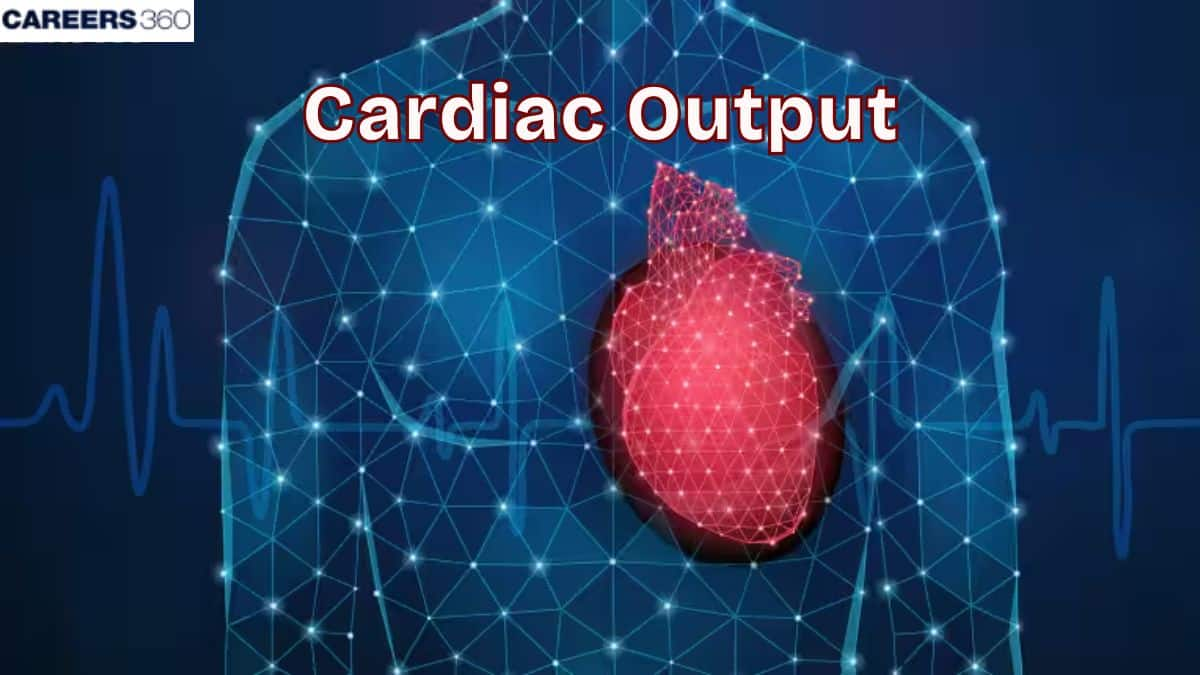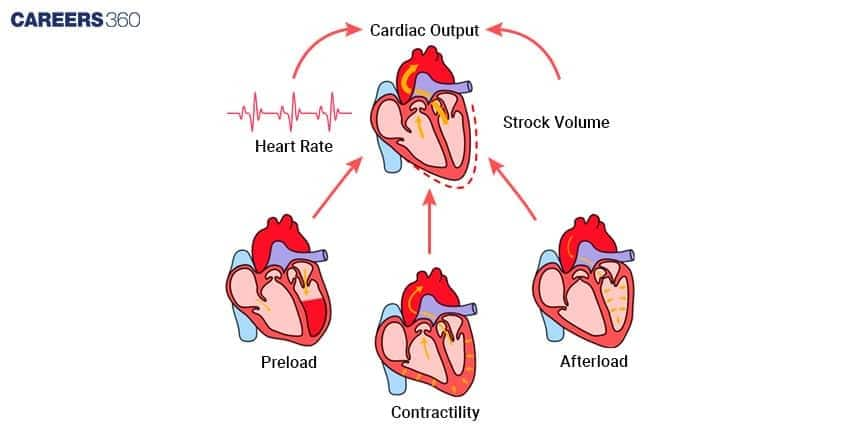Cardiac Output: Definition, Formula, Normal Range And Examples
Cardiac output is the volume of blood pumped by each ventricle per minute, determined by heart rate and stroke volume. It reflects the heart’s efficiency in supplying oxygen and nutrients to tissues and removing metabolic waste. This guide covers definition, factors, formula, regulation, measurement methods, variations, FAQs, and NEET MCQs.
This Story also Contains
- What is Cardiac Output?
- Cardiac Output Formula & Calculation
- Factors Regulating Cardiac Output
- Measurement of Cardiac Output
- Cardiac Index
- Regulation of Cardiac Output
- Normal Values and Variations
- Cardiac Output NEET MCQs (With Answers & Explanations)
- Recommended video on Cardiac Output

What is Cardiac Output?
Cardiac output can be defined as the amount of blood the heart produces per ventricle every minute. It is, therefore, vital for an individual to know how the heart supplies the body effectively through this form of measurement. Cardiac output is the product of heart rate and stroke volume. Heart rate is defined as the number of beats per minute, and stroke volume is the volume of blood pumped out with each beat from each ventricle.
Why Cardiac Output Matters
The resting cardiac output in a normal, healthy adult is approximately 5.0 litres per minute. Cardiac output ensures that an acceptable quantity of blood, along with the supply of oxygen and nutrients, reaches the tissues and organs. It also helps to deal with an elimination system within the system of waste products.
Cardiac Output Formula & Calculation
Cardiac output formula and calculations are discussed below:
Cardiac Output Formula
Cardiac output = Heart Rate(HR) x Stroke Volume(SV)
Cardiac Output Calculation
For example: If the heart rate is 70 bpm and stroke volume is 70 ml.
By the formula: HR X SV
= 70 beats per minute(bpm) X 70 ml
= 4900 ml/min or 4.9 litres per minute.
Factors Regulating Cardiac Output
The factors affecting cardiac output are:
Heart Rate: It is the number of times the heart beats in one entire minute and is used as a quantitative measure of cardiac activity. Increased heart rate generally results in improved cardiac output.
Stroke Volume: It is the quantity of blood pumped out at each heart contraction.
Preload: The EDV or volume of blood entering the ventricles.
Afterload: The arterial pressure or the resistance in the arteries which the heart must overcome to eject blood.
Contractility: The forcefulness of each heart contraction.
Venous Return: The volume of blood returning to the heart by the veins.
Physical Exercise: Exercise increases HR and SV leading to raised CO.
Pathological Conditions: Pathologic conditions of the heart, such as heart failure, tachycardia, or hypertension will alter the CO.
Measurement of Cardiac Output
The measurement of cardiac output can be done in several ways:
Direct Methods
Fick Principle
Thermodilution
Indirect Methods
Echocardiography
Doppler Ultrasound
Each method bears an advantage and a limitation in terms of accuracy and invasiveness.
Cardiac Index
Cardiac index is a haemodynamic measure that connects the body surface area to the cardiac output of the left ventricle in a minute.
Cardiac Output/Body Surface Area = Cardiac Index
The stroke volume divided by the body surface area is the stroke volume index.
Regulation of Cardiac Output
The cardiac output is regulated through:
Intrinsic Regulation
The Frank-Starling mechanism, where the increased venous return stretches the ventricles, causes stronger contractions to take place.
Extrinsic Regulation
Nervous and hormonal methods of control; for example, the autonomic nervous system and adrenaline.
Normal Values and Variations
The general normal range of cardiac output in most adults is about 4-8 litres per minute. Age, sex, and physical condition are other factors that could influence this. Abnormal cardiac output could mean terrible health problems.
Cardiac Output NEET MCQs (With Answers & Explanations)
Types of questions asked from this topic are:
Heart rate vs Pulse rate
Factors affecting heart rate and pulse rate
Practice Questions for NEET
Q1. Which among the following is correct during each cardiac cycle?
The volume of blood pumped out by the Rt and Lt ventricles is the same
The volume of blood pumped out by the Rt, and Lt ventricles is different.
The volume of blood received by each atrium is different.
The volume of blood received by the aorta and pulmonary artery is different.
Correct answer: 1) The volume of blood pumped out by the Rt and Lt ventricles is the same
Explanation:
After oxygenation, the volume of the blood entering the lung is the same as the volume of blood leaving it. In the case of varying volumes, the heart is susceptible to heart failure due to different pressures. If the volume of blood entering the lungs exceeds the capacity for oxygenation or drainage, it can cause fluid buildup, leading to pulmonary congestion. This imbalance in pressure can strain the heart, ultimately contributing to heart failure if left unaddressed.
Hence, the correct answer is option 1) The volume of blood pumped out by the Rt and Lt ventricles is the same.
Q2. Using which information can the amount of blood ejected from the left ventricle over a minute be calculated?
Heart rate and the fluid volume drunk on the day
Stroke volume and Circulating blood volume
Circulating blood volume and the fluid volume drunk on the day
Stroke volume and heart rate
Correct answer: 4) Stroke volume and heart rate
Explanation:
Stroke volume is the amount of blood ejected from the ventricle with each cardiac cycle. It can be readily calculated by subtracting the end-systolic volume from the end-diastolic volume. Multiplying the stroke volume by the heart rate yields the cardiac output, typically reported in liters per minute. A normal resting heart rate for adults ranges from 60 to 100 beats per minute.
Generally, a lower heart rate at rest implies more efficient heart function and better cardiovascular fitness. For example, a well-trained athlete might have a normal resting heart rate closer to 40 beats per minute.
Hence, the correct option is 4) Stroke volume and heart rate.
Q3. Which of the following definitions accurately describes cardiac output?
The amount of blood accumulated in the atrium before contraction.
The quantity of blood gathered in the ventricles during relaxation.
The volume of blood propelled from the atrium to the ventricles during contraction.
The quantity of blood expelled from the ventricles into the aorta and pulmonary artery.
Correct answer: 4) The quantity of blood expelled from the ventricles into the aorta and pulmonary artery.
Explanation:
Cardiac output refers to the amount of blood pumped out of the ventricles of the heart per unit of time, typically measured in liters per minute. It represents the volume of blood ejected from the ventricles and delivered into the systemic circulation (aorta) and pulmonary circulation (pulmonary artery). Therefore, option 4 accurately describes cardiac output.
Hence, the correct answer is option 4) The quantity of blood expelled from the ventricles into the aorta and pulmonary artery.
Also Read-
Recommended video on Cardiac Output
Frequently Asked Questions (FAQs)
Methods to determine cardiac output include the Fick principle, thermodilution, echocardiography, and Dopplers.
Cardiac output is affected by various factors such as heart rate, stroke volume, autonomic nervous activity, physical activity level, and pathological conditions.
Cardiac output is important in maintaining appropriate blood flow and enough oxygen delivery to the tissues.
Cardiac output would increase with exercise due to an increase in both heart rate and stroke volume.
